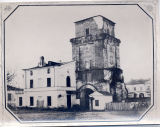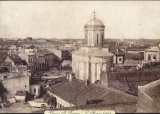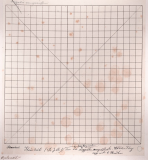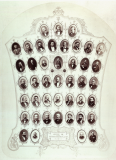Difference between revisions of "Ludwig Angerer"
| Line 110: | Line 110: | ||
* [http://cs.wikipedia.org/wiki/Ludwig_Angerer Angerer at Czech Wikipedia] | * [http://cs.wikipedia.org/wiki/Ludwig_Angerer Angerer at Czech Wikipedia] | ||
| − | {{featured | + | {{featured article}} |
{{DEFAULTSORT:Angerer, Ludwig}} | {{DEFAULTSORT:Angerer, Ludwig}} | ||
| + | [[Category:Photography]] | ||
Revision as of 16:49, 27 March 2013
 | |
| Born |
August 15, 1827 Malacky (Malaczka), Kingdom of Hungary, Austrian Empire |
|---|---|
| Died |
May 12, 1879 (aged 51) Vienna, Austria-Hungary |
Ludwig Angerer was a 19th-century pharmacist and photographer. He belonged to the most important Viennese photographers of his time, along with his brother Victor Angerer, Emil Rabending, and Josef Löwy. He was Franz Joseph I's court photographer, and introduced and popularised carte de visite photography in Vienna.
Contents
Early life
Born in Malacky, Kingdom of Hungary (today Slovakia). Son of a forester, second oldest of five kids. He spoke German, Hungarian, Latin, and Slovak. Angerer studied pharmacy, chemistry and physics in Pressburg (today Bratislava) and Pest. Starting 1848, for two years, he was a pharmacist apprentice, after which, at the age of 23, he gained a license in pharmacy, with the title of magister. Between 1850 and 1854, he was a pharmacist in Vienna and Graz.
Amateur photographer during Crimean War
On 13 March 1854, Angerer joined the army, becoming a military pharmacist at the Military Medicine Department and during Crimean War in 1856, he came to Bucharest with the Austrian occupation troops, working at their field hospital. During the two years he spent in Bucharest, apart from his pharmacist duties, during his spare time, Angerer practiced photography, taking some of the earliest photos of Bucharest, showing parts of the city before they were redeveloped during the late 19th century. He also took pictures of Russian troops, making him among the world's first war photographer (Roger Fenton, William Russell and others were part of the same war).
After the Austrian troops retreated in March 1857, Angerer returned to Vienna, where, a year later (on April 13, 1858), he resigned from the Army in order to focus on photography.
- Photographs
Photography practice
It is unknown when Angerer began photographing. In March 1849, together with his brother Victor, he captured a part of a 30-member Slovak delegation to the emperor Franz Joseph I. before they departed for Olomouc, counting Ľudovít Štúr and Michal Miloslav Hodža (the oldest preserved photograph of Slovak intelligentsia).
He founded his first photo studio in 1858, together with Hugo von Strassern. At the time 38 photographic studios were registered throughout the monarchy.[1] Two years later he moved to Theresianumgasse 6 to a new studio of his own. In April 1861 the studio served as meeting place for an exhibition committee set up by the Photograpic Society founded that year in Vienna.[2] In 1862 he moved to the neighboring house, which was his property (Theresianumgasse 4), where he built himself a magnificent and highly acclaimed studio.
By 1864 he was a member of the executive committee of the Photographic Society of Vienna, which brought him into contact with Anton Friedrich, then manager of Voigtländer's premises in Vienna. This led to Angerer acquiring and working with Voigtländer's recently introduced and massive 8-inch diameter Petzval-style portrait lens. It was Angerer's own lens which was displayed at the Berlin International Photographic Exposition in the following year. With this lens, he produced a series of very large format portraits, and his achievement was reported in the review of the exposition published in Photograpische Korrespondenz. Angerer exhibited there portraits, busts and three-quarter lengths. From the technical standpoint, these were highly successful and vigorous without retouching, but, unfortunately, they were not as much appreciated as the difficulty of their production made them deserve. The nucleus of his exhibit were the portraits, size 13 x 16 inches, taken with a smaller, 6-inch Voigtländer lens. This lens, introduced in 1860 in two different focal lengths, weighed in at a massive 31 lbs. The weight of the 8-inch version must have been considerable. So heavy was it that Angerer had to design a special tripod to carry the weight of the camera and its optic, with geared mechanisms to raise and lower the camera. Camera, lens and tripod reportedly weighed over two hundred pounds.[3]
In 1867 he opened another, larger studio, illuminated with blue glass skylights. Here he was joined by his brother Victor in 1872, thus named L & V.ANGERER. Victor had previously operated his own highly successful studio since the early 1860s. Their partnership, as L & V Angerer, lasted just over a year as Ludwig's health deteriorated and the operation of the studio passed solely to Victor. Ludwig died in 1879 and one of his sons and his daughter would, for a time, work as photographers in the family studio. The studio operated until the outbreak of the Great War in 1914.[4]
He portrayed the Austrian and foreign celebrities and also made city views of Vienna, genre- and animal studies. As an amateur, he made important work on the topography of the monarchy. Ludwig Schrank stated that Ludwig took landscape photographs near Brno, but the photographs are not preserved.[5]
- Photographs
Cartes
Angerer is credited with the introduction of the carte de visite (CDV) photographs into Vienna in 1857. These were small photographs of size of today's business cards which were very popular in the 1860s and 1870s. "Cartomania" was an international phenomenon, spanning Paris, London, and other places, and greatly contributed to popularisation of photography itself. The format was patented by André-Adolphe-Eugène Disdéri who in 1854 invented a machine to capture 8 portraits on one negative, which were then relatively easy and cheap to reproduce. Unlike more expensive and larger daguerrotypes, CDV photographs were exchanged among friends and placed in family albums. Many photographers were also selling portraits of known personalities, less commonly photographs of cities, sculptures or important events. In 1880s they were mostly replaced with larger cabinet photographs.
Court photographer
On December 25, 1860, he became the photographer of the Imperial Court in Vienna (k.k. Hof-Photograph). To obtain that title was not different to the procedure of becoming court supplier. The applicant had to put his proposal to the Hofmeisteramt (Controller to the Imperial Household). Angerer presented a portfolio with photographs. The Imperial office made inquiries with the help of the police and the censor’s department (Hofzensurbehörde): Ludwig Angerer was born at Malaczka in Kingdom of Hungary, his character was unblemished, he had the reputation of being one of the best photographers, he had a good income and – at that time – was unmarried. Not every applicant was appointed, even if he had fulfilled all the requirements. It was necessary to gain the emperor’s "highest resolution" ("allerhöchste Entschließung") to appoint a purveyor to the Court, whose profession was not yet bestowed with the title. It was the Emperor's expressed wish that the number of appointments should be low, to retain their value. The title was bound to the person. The only photographer who had the title bestowed upon him by the Court without application was Josef Löwy. He was not appointed Court photographer because of the high artistic quality of his pictures, but for his merit earned in connection with the World Fair in Vienna in 1873. Between 1860 and 1900 the title "k.k. Hof-Photograph" was awarded to 73 photographers, among them three women.[6]
In 1860, Angerer was the only photographer ever allowed to take a picture of all the Imperial family, where Empress Elisabeth can be seen together with her husband and children.[7]
Angerer sold large quantities of cartes and larger prints of the Imperial family, so did Emil Rabending. Elisabeth and Franz Josef attended Ludwig Angerer’s studio several times (always separately), but Angerer was not their private photographer, like Josef Albert was to King Maximilian II. or Ludwig II. of Bavaria. Whereas Albert even accompanied the King to different places, neither Angerer nor any other photographer was engaged to accompany and document the Emperor’s or Empress’s journeys.[8]
- Photographs
Family
Angerer's daughter married the photographer Johann Bauer. His first son Fery Angerer was not a professional photographer but doctor, he had a private sanatorium at the Mondsee and was an enthusiastic and recognized amateur photographer. His second son, August Angerer was an art dealer and his uncle Victor Angerer worked for him as a photographer.
Notes
- ↑ Fischer-Westhauser 2002, p. 72
- ↑ Auer 2002, p. 202
- ↑ Hannavy 2005
- ↑ Hannavy 2005
- ↑ Dufek 2002, p. 38
- ↑ Fischer-Westhauser 2002, p. 72
- ↑ Fischer-Westhauser 2002, p. 72
- ↑ Fischer-Westhauser 2002, pp. 72–73
References
- Auer, Anna (2002). ""The Photographic Society founded 1861 in Vienna"". Photography and Research in Austria: Vienna, the Door to the European East. Vienna: Dietmar Klinger.
- Dufek, Antonín (2002). ""By 1918: Paths from and to Vienna"". Photography and Research in Austria: Vienna, the Door to the European East. Vienna: Dietmar Klinger.
- Fischer-Westhauser, Ulla (2002). ""Court Photographers - Photographers for the Court?"". Photography and Research in Austria: Vienna, the Door to the European East. Vienna: Dietmar Klinger.
Literature
- Articles by Angerer
- "Ueber den Vergrösserungs-Apparat", Zeitschrift für Fotografie und Stereoskopie 3, 1861. (German)
- "Ueber eine Methode auf trockenem Kollod", ebd. 4, 1861. (German)
- "Ein neues System für Atelier-Stative", Photographische Correspondenz 3, 1866. (German)
- "Bericht über den photographischen Teil der Weltausstellung in Paris 1867", ebd. 4, 1867. (German)
- Articles on Angerer
- Margareta Savin, "Ludwig Angerer, unul din primii fotografi ai Bucureștilor", București: Materiale de Istorie și Muzeografie, VI/1968. (Romanian)
- A. Holzer, "Im Schatten des Krimkrieges. L. A.s Fotoexpedition nach Bukarest …", Fotogeschichte 24, 2004, Vol. 93, pp 23–50. (German)
- T. Starl, Lexikon zur Fotografie in Österreich 1839–1945, 2005. (German)





























